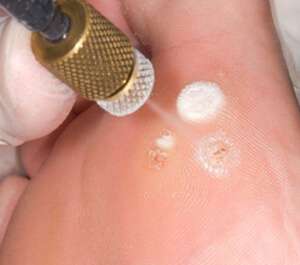Cryotherapy For Plantar Warts

What is Wart?
A wart is a small, rough growth that appears on the skin, caused by a viral infection. At Adelaide Physio and Podiatry Clinic in Pooraka, cryotherapy is a common treatment for warts. This involves applying liquid nitrogen to freeze the wart, which damages its cells and causes it to eventually fall off. The procedure is quick and relatively painless, but may require multiple sessions depending on the size and location of the wart. It is important to have warts evaluated and treated by our experienced podiatrist in Adelaide to ensure effective and safe treatment.
 What is Cryotherapy?
What is Cryotherapy?
Cryotherapy involves using liquid nitrogen to freeze plantar warts on the feet. At Adelaide Physio and Podiatry Clinic, we use a pressurised canister with a spray tip or contact probe. Each plantar wart receives three applications in each appointment, with each application lasting between 20 and 30 seconds, depending on the size of the plantar wart. The treatment is carried out quickly, and we have a good success rate when using cryotherapy to treat plantar warts in both children and adults.
Cryotherapy Plantar Wart Treatment
When you have a plantar wart, it usually has a firmer callus exterior that covers it. Your appointment starts with your podiatrist removing this callus to expose the wart. Don’t worry – callus is dead skin, so removing the callus itself is generally painless. You may feel a little tenderness if your wart is painful, but this is short-lived.
Due to a plantar wart’s extensive network of micro vessels (blood vessels within the wart), debriding the callus may cause small pin-point bleeds. Again, this is normal and is actually a good sign for a podiatrist, as it indicates that the callus is gone, and true verruca tissue has been exposed so the treatment will work directly on it.
Cryotherapy will then start and each lesion is treated. The treatment itself is mildly uncomfortable, but quite bearable. The frozen skin becomes white as the cells of tissue freeze, and will take approximately 30 seconds to thaw.
After the cryotherapy is complete, the surrounding skin may be tender for a day or so. A small blister may form as a result of the freezing and if this does happen, it is best not to pop it, but to cover the area with a band-aid or dressing. New skin will quickly grow and any scab or blister will soon disappear.
A follow-up appointment will be booked after the cryotherapy to monitor the lesion. As plantar warts are caused by a virus, the lifespan of the wart depends on your immune response to the treatment clearing away the wart tissue. This may require further treatments with cryotherapy over a period of a few weeks to destroy all of the infected tissue. Compared to other treatments, most people find freezing the most effective and the least time-consuming.
Cryotherapy FAQs
What is cryotherapy?
Cryotherapy is the use of extreme cold as part of a medical treatment. In podiatry, cryotherapy is used to freeze plantar warts, or verruca’s, to remove infected tissue and treat the warts.
How does cryotherapy work?
Cryotherapy uses liquid nitrogen to create extremely cold temperatures to destroy diseased tissue, such as the tissue found in plantar warts on feet. Once the diseased tissue is destroyed, the skin can heal, and healthy tissue can form in its place.
What does cryotherapy feel like?
Cryotherapy to remove warts can be mildly painful for a few seconds and feel similar to having an ice cube pressed against your skin. This discomfort is momentary and usually subsides within seconds.
What to expect in your consult?
On arrival, you’ll be greeted with a smile by our lovely admin team. You’ll then meet your podiatrist, who will listen to your history, work with you to perform a thorough assessment and begin treatment to get to the bottom of your concerns.
Your time is valuable, so you can complete your client forms either in person or online before your appointment to make things run smoothly. If you have any questions at all, please feel free to ask. We’re here to help!
We’ll stay in touch by sending personal emails or SMS (not bulk spam), and also ask for feedback after your appointments so we can continue to improve our service to you.